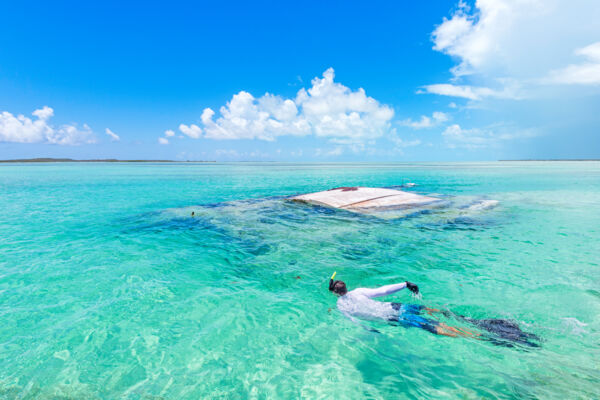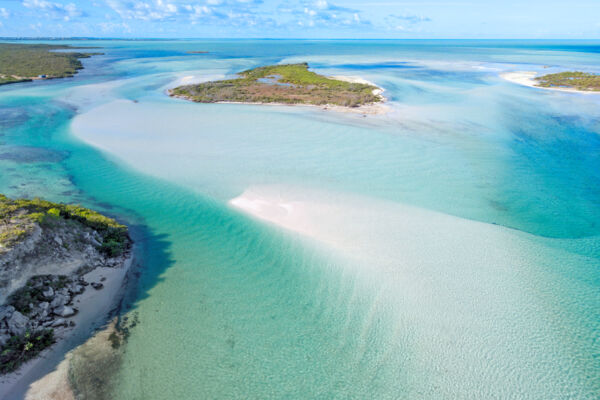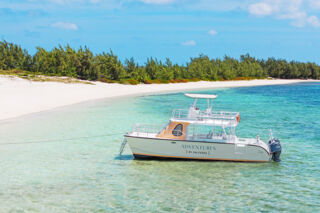South Caicos Snorkeling

South Caicos is an amazing destination for the outdoors and water sports, especially for fishing, scuba diving, kayaking, and snorkeling. Due to the island’s location on the eastern edge of the Caicos Banks and Caicos Islands archipelago, the surrounding waters are a mixing ground for many marine environments. Consequently, they are a haven for wildlife.
The shallows, red mangrove wetlands, sandy channels between the cays, the barrier reef, and the depths of the Turks Islands Passage collectively create a spectacular range of underwater settings.
Weather and Ocean Conditions
South Caicos tends to be exposed to the consistent eastern trade winds and swell of the open ocean more than many of the other islands in the Turks and Caicos. Because of this, the best snorkeling is typically found at sheltered locations on the lee side of the land.
Usually, wind speeds under 10 mph (16 km/h) paired with low or no ocean swells are most conducive to pleasant snorkeling.
Beach Snorkeling Locations

Salterra Beach
Salterra Beach is one of the more extensive beaches on South Caicos. Interesting snorkeling can be had in the seagrass beds fronting the coast and along the rocky coasts that fringe the western and eastern sides of the beach.
This beach is easily accessible (especially for guests of the Salterra Resort & Spa), yet is a little more susceptible to wind and choppy ocean conditions than some of the other beach snorkeling sites. Starfish, turtles, conch, and small sharks can be seen in the area.
Jerry Camp
Jerry Camp, a water access near Plandon Cay Cut, is a unique snorkeling location on the far northern peninsula of South Caicos. This wetland sound location doesn’t offer much in the way of coral and reefs, yet is an excellent spot for seeing larger sea creatures such as nurse sharks and lemon sharks, southern brown stingrays, eagle rays, turtles, and shallows and channel fish such as barracuda, bonefish, snappers, jacks, and permit.
This landing and water access is a natural funnel point for wildlife traveling between the islands, and the area has been used by fishermen since before the arrival of Columbus in the New World.
The area to the north of Jerry Camp is Plandon Cay Cut, one of the most beautiful vistas in the Turks and Caicos.
Highlands Bay
During abnormally calm weather conditions, the beautiful Highlands Bay coastline of South Caicos offers varied and interesting snorkeling. Directly off the coastal cliffs here are vibrant reefs and coral.
The best section of the reef is found at the far southeastern point of the beach and South Caicos.
Snorkeling Boat Excursions

The best way to snorkel at South Caicos is to take a snorkeling charter with a knowledgeable captain. There are countless reefs surrounding the island that are too far out to swim to, yet typically offer vibrant coral and great underwater visibility.
A few charter companies offer snorkel cruises to the island's best reefs. Salterra Resort also runs snorkeling excursions for its guests through its water sports center, Adventures by Salterra.
Long Cay
Long Cay is an exquisite national park island near Cockburn Harbour on South Caicos. As its name suggests, the island is very long at over 3 miles (5 km), yet is very narrow. The eastern and western sides of the cay are quite contrasting, with the deep blue of the Turks Islands Passage on one side and the shallow turquoise of the Caicos Banks on the other.
The best snorkeling at Long Cay can be found at the northern and southern ends of the cay.
Long Cay offers much more than just snorkeling. Incredible beaches with breathtaking turquoise water line the western side of the cay, and its inland areas are home to the endangered Turks and Caicos Islands rock iguana.
Dove Cay
The tiny rock island of Dove Cay is located quite close to South Caicos and is another great snorkeling site. Due to the cay’s location in the channel between South Caicos and Long Cay, there’s a good chance of spotting larger sea life such as eagle rays, turtles, and sharks. Water visibility here is typically amazing.
- Be aware of currents. The channels surrounding South Caicos typically have significant water movement due to tide changes. These currents often fade quickly once outside of the natural restrictions, yet it’s important to monitor water movement so as to avoid difficulties.
- If you’re unsure in the water, snorkel with a knowledgeable guide and wear a personal flotation device. Local tour captains know the best snorkeling locations, and will offer the best chance to see interesting sea creatures.
- Please use reef-safe sunscreen. Conventional sunscreens that contain oxybenzone or octinoxate have been proven to cause lasting damage to corals and reefs. Look for a sunscreen with zinc oxide or titanium dioxide, or better yet, wear a rashguard.
- Many of the South Caicos snorkeling, scuba diving, and water sports locations are inside either the Admiral Cockburn Land and Sea National Park or the Bell Sound Nature Reserve. It is illegal to fish or take any natural or historical object from a protected area.
- Many animals on the reef are capable of inflicting painful stings and bites, including several types of coral, lionfish, scorpionfish, and many smaller creatures. Do not touch anything on the reef.

